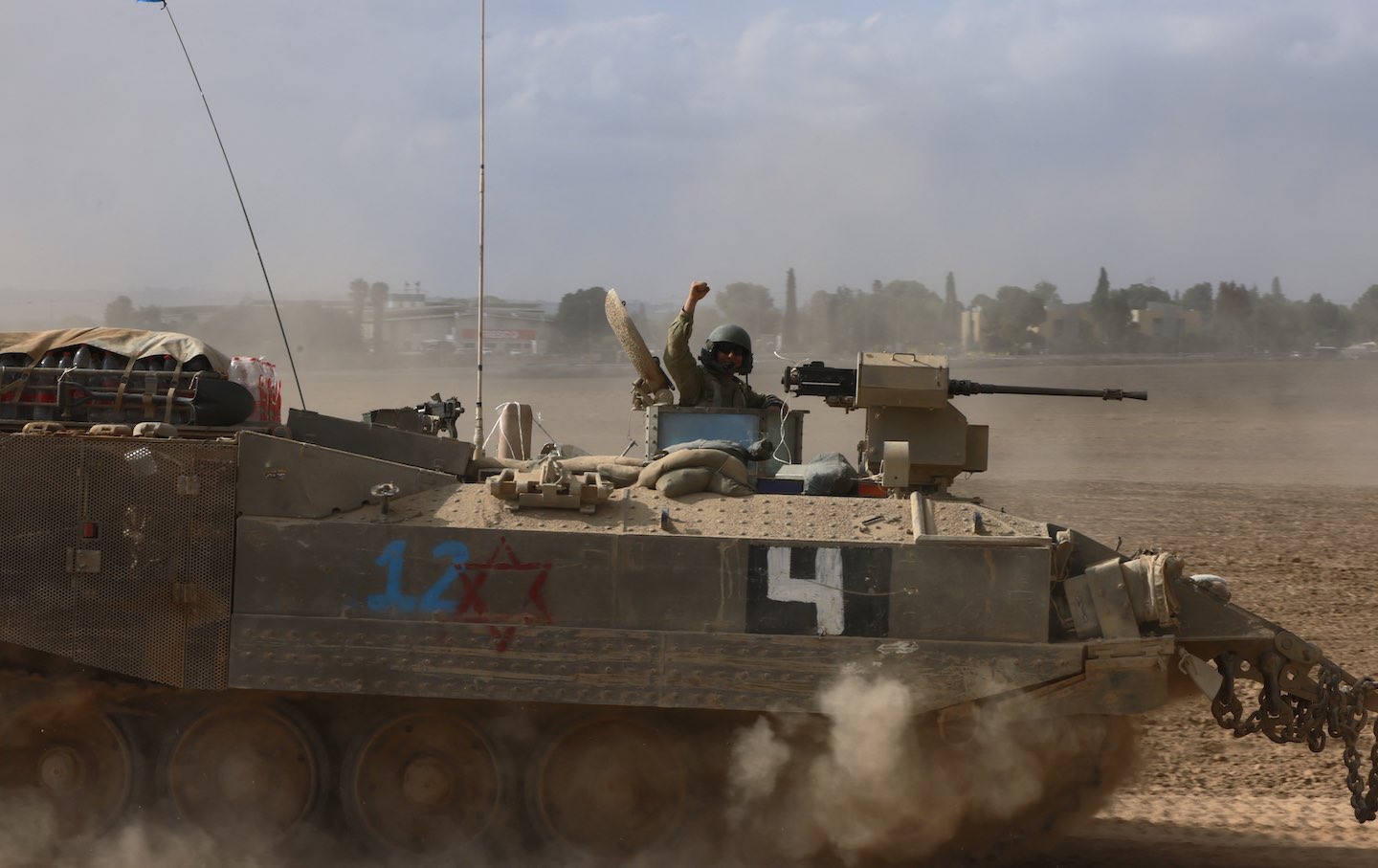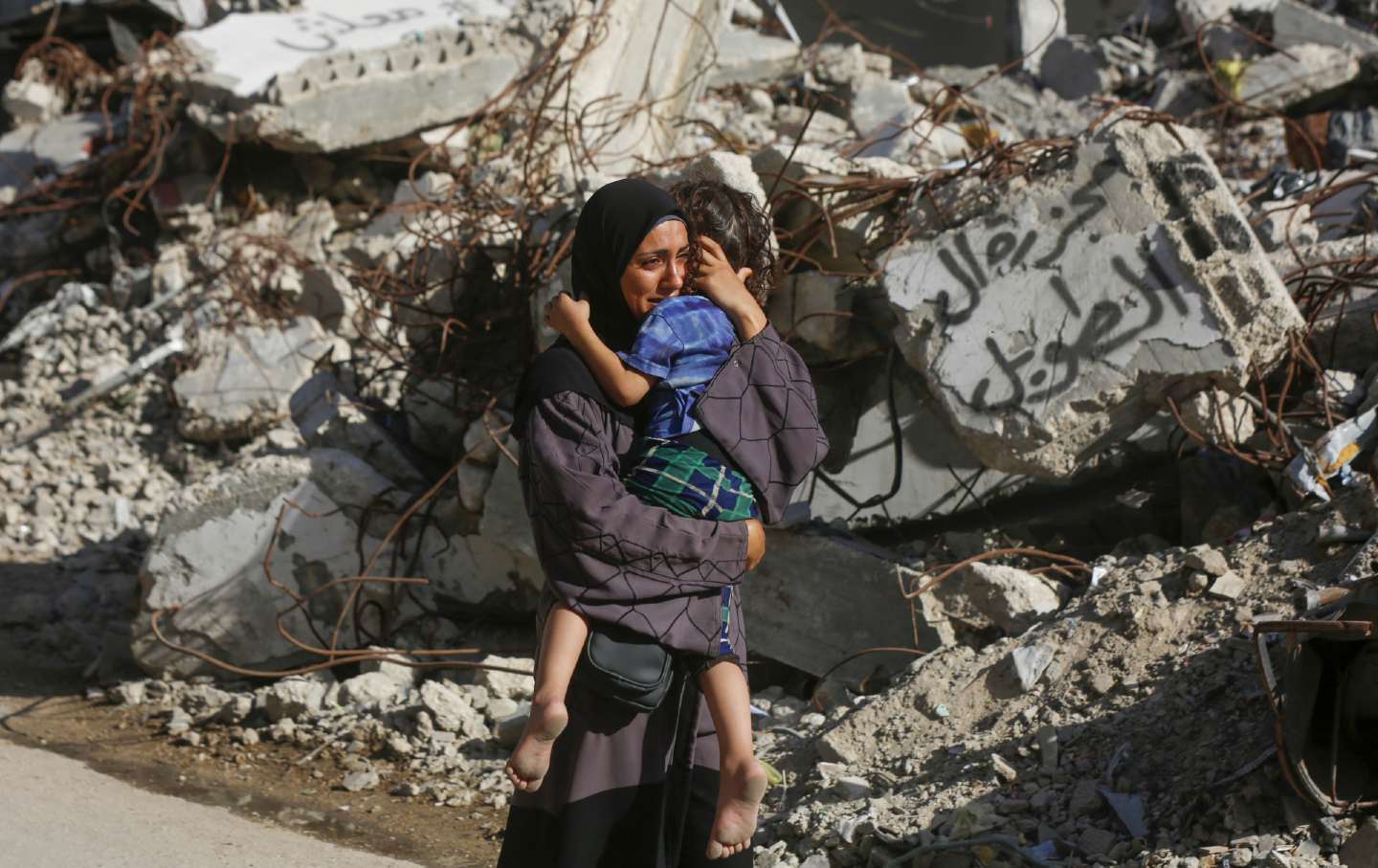Israel Is Killing Whole Families in Gaza—With Weapons Made in America
Five-year old Hind Rajab was the victim of a bomb manufactured in Iowa. Months later, the Biden administration is still sending weapons.

An Israeli army tank drives in an area near Israel’s southern border with the Gaza Strip on October 6, 2024.
(Menahem Kahana / AFP)With half the world between them, there seems little to connect the bucolic Iowa village of Middletown, nestled along the Mississippi River, with the macabre moonscape of bombed-out apartment buildings on top of rotting corpses in the densely populated Tel al-Hawa (“Hill of the Wind”) neighborhood in the southern part of Gaza City. But the two have long been intimately entwined, especially since the morning of January 29, 2024, though few have come to realize it.
That morning, after a night of bombings, the Israeli military was planning another deadly assault on Tel al-Hawa, and at 9:32 am it issued an order for the residents to evacuate immediately. Among those who heeded the order were Bashar Hamada and his family, who had evacuated to Tel al-Hawa from their home in another part of the city following an earlier attack. By then, according to the United Nations, 1.7 million people in Gaza—about 75 percent of its 2.2 million residents—had been internally displaced by the deadly assaults, with many displaced multiple times. On that cold and rainy Monday morning, Bashar, 44, and his wife Anam, 43, quickly packed into the family car their four children and their 6-year-old niece, Hind Rajab, who had dreams of becoming a dentist. Hind’s mother, Wissam Hamada, stayed behind and would follow later. “They were firing on anyone moving in the street,” she later told Al Jazeera.
Almost immediately, Bashar realized he was in trouble, as the Israeli military swarmed the area and began opening fire. Hoping to avoid the bullets, he pulled his black Kia Picanto into the nearby Fares gas station. It was to no avail. Wissam called Bashar to check on them, but it was her 15-year-old niece, Layan, who answered the phone. “Only Hind and I are alive,” she screamed through sobs. “Hind is injured. Hind is bleeding. I’m bleeding.” The family then called the Palestinian Red Crescent Society (PRCS), asking them to send an ambulance to the gas station. Omar Al-Qam, the PRCS dispatcher, quickly called the car and Layan answered. “They are shooting at us,” she screamed into the phone, according to a recording of the conversation. “They are shooting at us. The tank is next to me.” Seconds later, there were only screams, as the sound of rapid machine gun fire could clearly be heard. Layan was never heard from again. A later analysis determined that the phone captured the sound of 64 gunshots fired from a tank in just six seconds.
But before an ambulance could be dispatched, approval would first need to be obtained from Israeli authorities, a process that would take an inexcusable three hours. Inside the PRCS emergency center, where a sign reading “Targeting medical missions is a war crime” is affixed to a window, the dispatcher called back to the car. This time, it was Hind who answered the phone. Layan was dead, she told the dispatcher, then screamed, “The tank is next to me.… It’s moving in front of the car.” When asked if it was close, she replied, “Very, very… Come get me, come get me.… I’m so scared, please come!” Eventually, the dispatcher was able to patch Hind’s mother into the call. “I’ve been shot in my upper arm, my back, and my foot,” the 6-year-old told her.
Satellite imagery taken that day shows numerous Israeli tanks in close proximity to where the car was attacked. And a scientific investigation by Forensic Architecture concluded that the shooter would have had a clear view of the car and its passengers. In other words, they would have been aware of the presence of two children. “The shape of the depression of the windshield,” the report adds, “suggests that it was run over by a light vehicle such as an Israeli military bulldozer made by Caterpillar.”
Hours later the ambulance was nearby. “I’m coming up to the gas station,” the driver told Hind, “Oh, there it is.” But immediately, there was the sound of an explosion and the phone went dead. The family then called Hind, who said she was alive and had heard an explosion nearby. Her voice, however, was growing weaker and she said her mouth was bleeding. That was last they heard from their daughter.
Twelve days later, the Israeli military finally withdrew, and the seven decomposing bodies of the family, including Hind, were discovered. The investigation found a total of 335 bullet holes, from a tank-mounted machine gun, in the car. About 50 meters away was the twisted and demolished wreckage of the ambulance, along with the bodies of the two paramedics, also victims of an Israeli tank. The medical personnel in the ambulance had been killed by the tank’s powerful cannon—another in the long list of Israel’s war crimes. Among the debris was a fragment from a 120-mm artillery shell clearly labeled M830A1, along with a serial number. It’s a shell designed to destroy tanks, not ambulances.
That label and serial number traced back to the Iowa Army Ammunition Plant, located in Middletown, population 336. The area’s largest employer, the massive Ammunition Plant is housed on 19,011 acres and operated by the defense contractor American Ordnance, LLC, a subsidiary of Day & Zimmerman.
The plant is just one of numerous defense contractors across the country feeding Israel with its bombs, bullets, and shells to bring death and destruction to more than 41,000 Palestinians—mostly innocent women and children like Hind and her family—and medical workers like the ambulance paramedics. And they’re met with no pushback from Washington, despite overwhelming evidence of brutal war crimes—violations of the Biden administration’s own arms transfer policy, meant to ensure that American-made weapons are used in accordance with international law, as well as the Leahy Law, which prohibits assistance to foreign military units that commit abuses.
According to a study on the costs of war released last week by Brown University’s Watson Institute, the United States has spent at least $22.76 billion in taxpayer dollars on military aid to Israel and the region in the year since the war started on October 7, 2023. That includes numerous American-made critical parts for the tank that targeted Hind and her family; powerful American-made bombs like those dropped on her apartment block and on refugee camps, killing thousands in an instant; the American-made anti-tank shells like those that targeted the ambulance carrying the paramedics racing to her rescue; and American-made Caterpillar tractors like the one that crushed Bashar Hamada’s car in a final surreal attempt to obliterate the family inside.
By last March, according to Responsible Statecraft, the Biden administration had already greenlighted more than 100 separate American weapons deals for Israel, or about one every 36 hours. That meant boom times for “Bombville”—McAlester, Oklahoma, the small town where the mammoth McAlester Army Ammunition Plant is located, and where America’s biggest non-nuclear bombs are built, before being shipped off to Israel. Behind high fencing, the facility occupies a 70-square-mile site—bigger in area than Washington, DC. The idea was to construct buildings far apart from each other so an explosion in one won’t cause a chain reaction.
Among McAlester’s products is the 2,000-pound MK-84, manufactured by General Dynamics Ordnance and Tactical Systems. Since October 7, 2023, the Pentagon has shipped more than 14,000 of these behemoths to Israel for use in tiny, tightly packed Gaza. Enormously deadly and destructive, the MK-84 is four times heavier than the largest bombs the US let loose in Syria and Iraq in its war against ISIS. Its streamlined steel casing is loaded with 945 pounds of high explosive and can create a crater 50 feet wide and more than three stories deep. It can also penetrate up to 15 inches of metal or 11 feet of concrete, and causes lethal fragmentation to a radius of 400 feet. Nevertheless, Israel decided to drop them on overcrowded refugee camps in Gaza, where half the population is made up of children.
According to Responsible Statecraft, in the first month of its war on Gaza, Israeli forces dropped more than 500 MK-84s—more than 40 percent of which targeted Israeli-designated densely packed safe zones. By six weeks into the war, it had dropped 2,000-pound bombs more than 200 times. A UN investigation noted that heavy American-made bombs were also dropped on “residential buildings, a school, refugee camps and a market” on six occasions between October 9 and December 2, 2023, killing at least 218 people. “The number of fatalities could be much higher,” the UN noted. Amnesty International called the attack on the crowded Jabaliya refugee camp with one or two GBU-31s (modified MK-84s), “damning evidence of war crimes.” And an analysis by the UN Office of the High Commissioner on Human Rights determined that there was no military objective to justify the strike. But the bombs kept coming.
Popular
“swipe left below to view more authors”Swipe →Such war crimes, conducted with massively destructive weapons stamped, in essence, “Made in the USA,” have now continued nonstop for more than a year, leaving over 41,000 people dead and nearly 100,000 injured, and clearly making the US a cobelligerent in the ongoing genocide. It’s as if someone is continually loading the gun as a serial killer routinely commits mass murder. In August, the Euro-Med Human Rights Monitor counted more than 2,750 families who had lost at least three members to Israeli attacks over the previous 11 months. Over 365 Gazan families have lost more than 10 members in the ongoing war.
“These are not isolated incidents: Many families have seen several generations wiped out in a single strike,” Euro-Med chairman Ramy Abdu told Le Monde. “It’s as if entire families disappeared overnight.” Among those interviewed by Le Monde in the past few weeks was Youssef Salem, 34, who has thus far lost 270 members of his extended family. The oldest was 90, the youngest just a few months old. “These were my uncles, my cousins, my aunts, their children and grandchildren,” he explained. “In Gaza, we’re all very close. We grow up together. We marry each other and we support each other.”
Which is why Israel takes elaborate measures to hide from the world any bomb and shell fragments scattered among the bloody corpses—fragments that might be traced back to the United States and cause the American public to question its deadly involvement in the war. Such measures also include barring foreign journalists from entering Gaza, or attacking or killing them while doing their job. As of October 11, 2024, according to the Committee to Protect Journalists, at least 128 journalists and media workers have been killed in Gaza, the West Bank, and Lebanon since the war began, “making it the deadliest period for journalists since CPJ began gathering data in 1992,” the group said.
To slightly paraphrase Nietzsche, “He who fights along with monsters might take care lest he thereby become a monster.” For America, however, this warning might already be too late.
Hold the powerful to account by supporting The Nation
The chaos and cruelty of the Trump administration reaches new lows each week.
Trump’s catastrophic “Liberation Day” has wreaked havoc on the world economy and set up yet another constitutional crisis at home. Plainclothes officers continue to abduct university students off the streets. So-called “enemy aliens” are flown abroad to a mega prison against the orders of the courts. And Signalgate promises to be the first of many incompetence scandals that expose the brutal violence at the core of the American empire.
At a time when elite universities, powerful law firms, and influential media outlets are capitulating to Trump’s intimidation, The Nation is more determined than ever before to hold the powerful to account.
In just the last month, we’ve published reporting on how Trump outsources his mass deportation agenda to other countries, exposed the administration’s appeal to obscure laws to carry out its repressive agenda, and amplified the voices of brave student activists targeted by universities.
We also continue to tell the stories of those who fight back against Trump and Musk, whether on the streets in growing protest movements, in town halls across the country, or in critical state elections—like Wisconsin’s recent state Supreme Court race—that provide a model for resisting Trumpism and prove that Musk can’t buy our democracy.
This is the journalism that matters in 2025. But we can’t do this without you. As a reader-supported publication, we rely on the support of generous donors. Please, help make our essential independent journalism possible with a donation today.
In solidarity,
The Editors
The Nation








